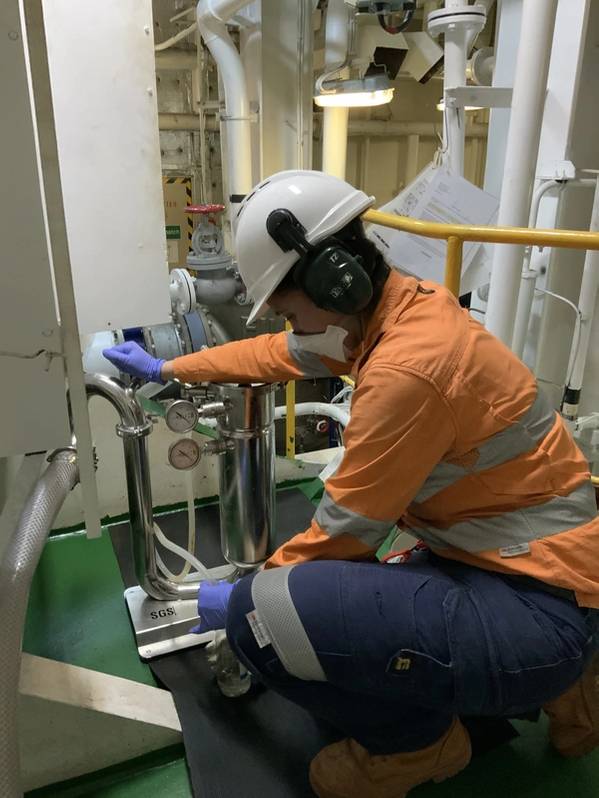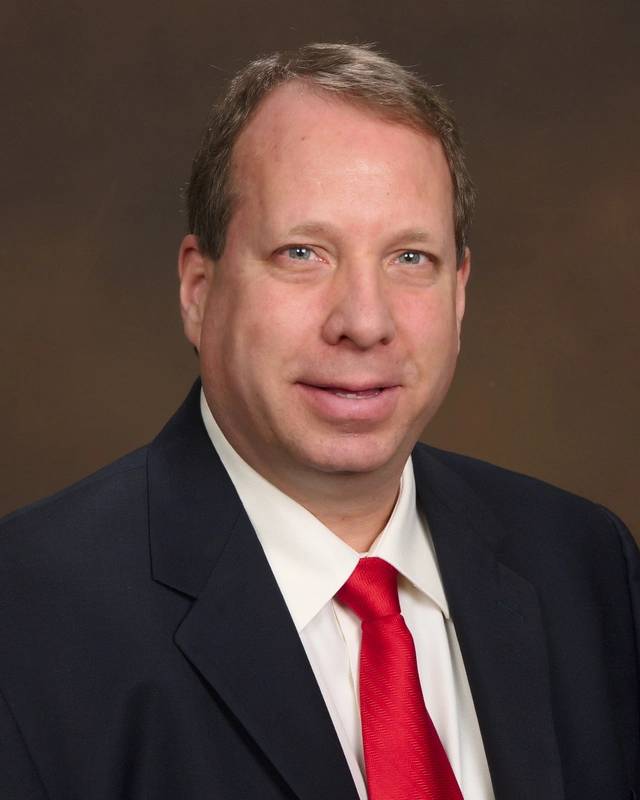Vessel Ballast Water Management: Getting the Numbers Right
Sept 10, 2024

Ballast water sample. Image courtesy SGS.
It was never going to be realistic to expect treated ballast water to have zero viable organisms on discharge.
The G8 guidelines that define the type approval process for ballast water treatment systems were initially agreed at the IMO before any systems had actually been developed.
The IMO had already been working on the issue of invasive species being transferred around the world in ballast water for a couple of decades. It was on the radar back in the 1970s. At MEPC 31 in 1991, the IMO adopted voluntary guidelines that focused on non-release of ballast water, ballast water exchange or discharge into shoreside reception facilities. Onboard treatment systems were mentioned as a possibility for future research.
In the years after the adoption of the Ballast Water Management Convention in 2004, treatment systems grew in type and number, and over 80 gained type approval. However, G8 specified a limited salinity range for testing these systems, and there were no requirements to test with fresh water or different water temperatures. Concern had also been raised about the need to only monitor the effectiveness of the disinfection process for five days. In any case, G8 was only guidance and results could reflect the individual nature of the test water obtained near a particular testing house.
Then the US Coast Guard refused to embrace treatment that rendered organisms permanently non-viable although not necessarily dead. This caused OEMs that use UV treatment to meet two different standards to gain global approval for their systems.
Fast forward to MEPC 81 in March this year, six months before all ships have to comply with the D-2 standard (requiring treatment rather than just exchange), depending on survey anniversary, and the details are still being resolved. After much discussion and three rounds of votes, text for the interim guidance for ships ballasting in challenging, high sediment water was finally approved.
 Ballast water sampling. Image courtesy of SGS.
Ballast water sampling. Image courtesy of SGS.
The Nature of the Beast
The control of invasive species has proved to be an ongoing battle against the diversity and tenacity of life. The round goby epitomizes the ability of some species to not only survive but thrive in new environments. It is a voracious and aggressive fish; a renowned invader that has been transferred to many countries. Originally from the Black and Caspian Seas, it thrives in a range of salinities, warm or cool water, and on a wide variety of foods.
It’s now at home in the Great Lakes, along with zebra and quagga muscles, amongst others, many considered to have arrived in ballast water. No new instances of invasive species have been reported since ballast water exchange was fully implemented by ships before entering the seaway, but lakers, operating only within the seaway, have spread those already introduced further. A study published this year found that untreated samples from lakers could contain thousands of eggs or resting stages of organisms per cubic meter of ballast water.
Despite its success in the Great Lakes, ballast water exchange hasn’t been considered adequate because even vessels with no ballast on board have been found to harbor living organisms in sediments left in the bottom of their tanks, ready for dispersal when ballasting is undertaken again.
Counting on Performance
It’s tempting to believe that the efficacy of treatment systems has improved over time as the industry has developed and regulations have been tightened. A study of 228 ships during 2017–2023 found that this was not the case. Nearly all ships were compliant with the D-2 standard for indicator microbes and organisms <50μm, but almost half of all samples exceeded the limit of 10 viable organisms per cubic meter for organisms ≥50μm.
Inspection house SGS has played an important role in developing sampling and testing techniques for taking representative samples of the large volumes required to verify that ship’s discharges meet the D-2 standard. The company has conducted compliance testing and commissioning testing on over 2,000 vessels worldwide.
 Shipowners who are put in position where they must bypass the system are often considered ‘guilty’ and can get a bad environmental reputation. Manoj Subramanian, International Chamber of Shipping (ICS) Marine Technical Adviser. Image courtesy ICS
Shipowners who are put in position where they must bypass the system are often considered ‘guilty’ and can get a bad environmental reputation. Manoj Subramanian, International Chamber of Shipping (ICS) Marine Technical Adviser. Image courtesy ICS
“Our sampling experts often work alongside crews during sampling events, providing valuable training,” says Cameron Talbot, Australian Marine Services Manager at SGS Australia. “As compliance and voluntary due diligence sampling become more widespread, I anticipate that crews will gain expertise in critical sampling aspects, such as the disposal of filtrate and the maintenance of sampling points. Regular sampling will also offer vessel operators better insights into whether their systems and procedures meet the D-2 performance standard, leading to higher compliance rates and enhanced protection of the marine environment.
“Currently, compliance is often assumed rather than verified.” He says, many port state controls may require assistance to build capacity for this task or may need to collaborate with specialized, accredited laboratories.
Pointing the Finger
By September 8, 2024, an estimated 40,000 ships will have installed a treatment system. The phased approach to compliance between entry into force on September 8, 2017 and September 8, 2024, was widely seen as a victory for common sense, as it gave OEMs, shipyards and shipowners time to install so many systems.
However, it has also been the start of more problems for shipowners. Manoj Subramanian, International Chamber of Shipping (ICS) Marine Technical Adviser, says it is still common for a ballast water management system to be bypassed during ballasting, and it is increasingly difficult for relevant stakeholders to determine what went wrong, whose fault it was and how to improve the situation. It is important to note, he says, that it is significantly more difficult for the ship to meet D-2 standards once the ballast water management system is bypassed.
“Shipowners who are put in position where they must bypass the system are often considered ‘guilty’ and can get a bad environmental reputation, as it is seen as choosing an inferior, cheaper ballast water management system, but they are caught in a difficult regulatory situation.
“Rather than holding the shipowners solely responsible for bypassing the system, the inherent flaws in the system must be addressed. Therefore, ICS strongly advocates for a more consistent regulatory approach that results in a more uniform and stricter set of requirements from the type approval stage of a system to the implementation stage of the Ballast Water Management Convention.”
ICS has identified several root causes that crews might have for bypassing their ballast water management system: unfamiliarity with the equipment onboard the ship and gaps in the information provided by the manufacturer's manual, lack of timely support, machinery not fit for purpose in real-life conditions and a lack of availability of spares.
 In reality, for all practical purposes, we have just started talking about challenging water quality and malfunctioning ballast water treatment systems.
In reality, for all practical purposes, we have just started talking about challenging water quality and malfunctioning ballast water treatment systems.
William H. Burroughs, Founder and CEO of Monstrant Viam
Redrawing the Battle Lines
An experience building phase was established at MEPC 71 in 2017 and then a review plan was approved at MEPC 80 in 2023 that allows for amendments to the convention in 2026.
“This is 10 years too soon,” says industry veteran William H. Burroughs, Founder and CEO of Monstrant Viam, who has variously worked on class, OEM development, research and regulation development projects. “In reality, for all practical purposes, we have just started talking about challenging water quality and malfunctioning ballast water treatment systems. That is not going to be solved for another decade or more. Amendments are being drafted for the Convention now. It is important to get approval for the use of mobile BWMS either for contingency measures or for portable systems shared across a fleet of vessels.”
He is working to get recognition for “ballast water reception ready” treatment systems that have pipework that enables ships to discharge to shore. “These retrofits will be 10% of the cost of installing a ballast water management system and nothing compared to the lifecycle maintenance and operating costs of a system.”
Shoreside treatment systems will serve a regulatory purpose when onboard systems fail to meet D-2, and they could also be a source of pre-treated, fully IMO compliant ballast water to ships, he says. It would, however, require a change to US Coast Guard regulations.
A Victory Unnoticed
For now, there’s little point trying to determine whether the number of invasive marine species is declining. Such studies are tricky at best as is the conclusion that a species has been introduced from ballast water when other mechanisms (biofouling, aquaria release, etc) could also be feasible. And, by definition, the Convention’s limits on the number of viable organisms allowed to be discharged are above zero.
If the transfer rate of potentially invasive species is never going to be zero, are complex, expensive and time-consuming mitigation efforts worth it? Organizations such as the Intergovernmental Science-Policy Platform on Biodiversity and Ecosystem Services could point to the billions of dollars lost in infrastructure and biodiversity as justification for action, but a study of the Port of Douala, Cameroon, offers a more focused approach for port states.
Cameroon receives 95% of its merchandise via maritime transport, and Douala receives ballast water from 41 ports and 20 eco-regions. Examining specific trades, such as those from: Antwerp, Durban and Dakar, the researchers evaluated the invasion risks that could be mitigated by compliance with D-2. They modelled the probability of a species being an alien based on biogeographic dissimilarity, the probability of its introduction based on ballast water volume, voyage time and treatment efficiency, and the probability of its establishment based on the similarity of factors such as salinity and water temperatures between the two ports. They concluded that the D-2 standard would reduce the probability of biological invasion at Douala by at least 97%. At least 97% but not 100%.
Technology
Marine Equipment
Ballast Water Treatment
Ballast Water Management Systems
Green Ports